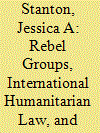|
|
|
Sort Order |
|
|
|
Items / Page
|
|
|
|
|
|
|
| Srl | Item |
| 1 |
ID:
172832


|
|
|
|
|
| Summary/Abstract |
Do rebel group violations of international humanitarian law during civil war—in particular, attacks on noncombatant civilians—affect conflict outcomes? I argue that in the post-Cold War era, rebel groups that do not target civilians have used the framework of international humanitarian law to appeal for diplomatic support from Western governments and intergovernmental organizations. However, rebel group appeals for international diplomatic support are most likely to be effective when the rebel group can contrast its own restraint toward civilians with the government's abuses. Rebel groups that do not target civilians in the face of government abuses, therefore, are likely to be able to translate increased international diplomatic support into more favorable conflict outcomes. Using original cross-national data on rebel group violence against civilians in all civil wars from 1989 to 2010, I show that rebel groups that exercise restraint toward civilians in the face of government violence are more likely to secure favorable conflict outcomes. I also probe the causal mechanism linking rebel group behavior to conflict outcomes, showing that when a rebel group exercises restraint toward civilians and the government commits atrocities, Western governments and intergovernmental organizations are more likely to take coercive diplomatic action against the government. The evidence shows that rebel groups can translate this increased diplomatic support into favorable political outcomes.
|
|
|
|
|
|
|
|
|
|
|
|
|
|
|
|
| 2 |
ID:
141185


|
|
|
|
|
| Summary/Abstract |
In nearly two-thirds of civil wars since 1989, governments have received support in their counterinsurgency operations from militias. Many scholars predict higher levels of violence in conflicts involving pro-government militias because governments are either unable or unwilling to control militias. This article challenges this view, arguing that governments can and do often control militia behavior in civil war. Governments make strategic decisions about whether to use violence against civilians, encouraging both regular military forces and militia forces to target civilians or restraining regular military forces and militia forces from attacking civilians. In some cases, however, government and militia behavior differs. When a militia recruits its members from the same constituency as the insurgents, the militia is less likely to target civilians, as doing so would mean attacking their own community. Statistical analyses, using new data on pro-government militia violence in civil wars from 1989 to 2010, support these arguments.
|
|
|
|
|
|
|
|
|
|
|
|
|
|
|
|
| 3 |
ID:
153909


|
|
|
|
|
| Summary/Abstract |
Why do armed groups ever direct violent attacks against humanitarian organizations? While scholars have analyzed wartime violence against civilians, little research exists on violence against other noncombatants, like humanitarian organizations. Violence against aid workers, however, is common in wartime, with devastating consequences for civilians, who suffer when aid organizations respond by reducing services. This article argues that much of the violence against humanitarian organizations is strategic. By serving as substitute providers of public goods, aid organizations can bolster the government. Insurgents thus target aid workers in an effort to force them out of particular regions, undermining government support. To test this argument, we analyze variation in violence across space and time using an original panel dataset on attacks against aid workers in Afghanistan, 2008–2012. Despite aid organizations’ attempts to remain neutral, we find evidence that insurgents strategically target aid workers in areas where their services likely strengthen government support.
|
|
|
|
|
|
|
|
|
|
|
|
|
|
|
|
|
|
|
|
|